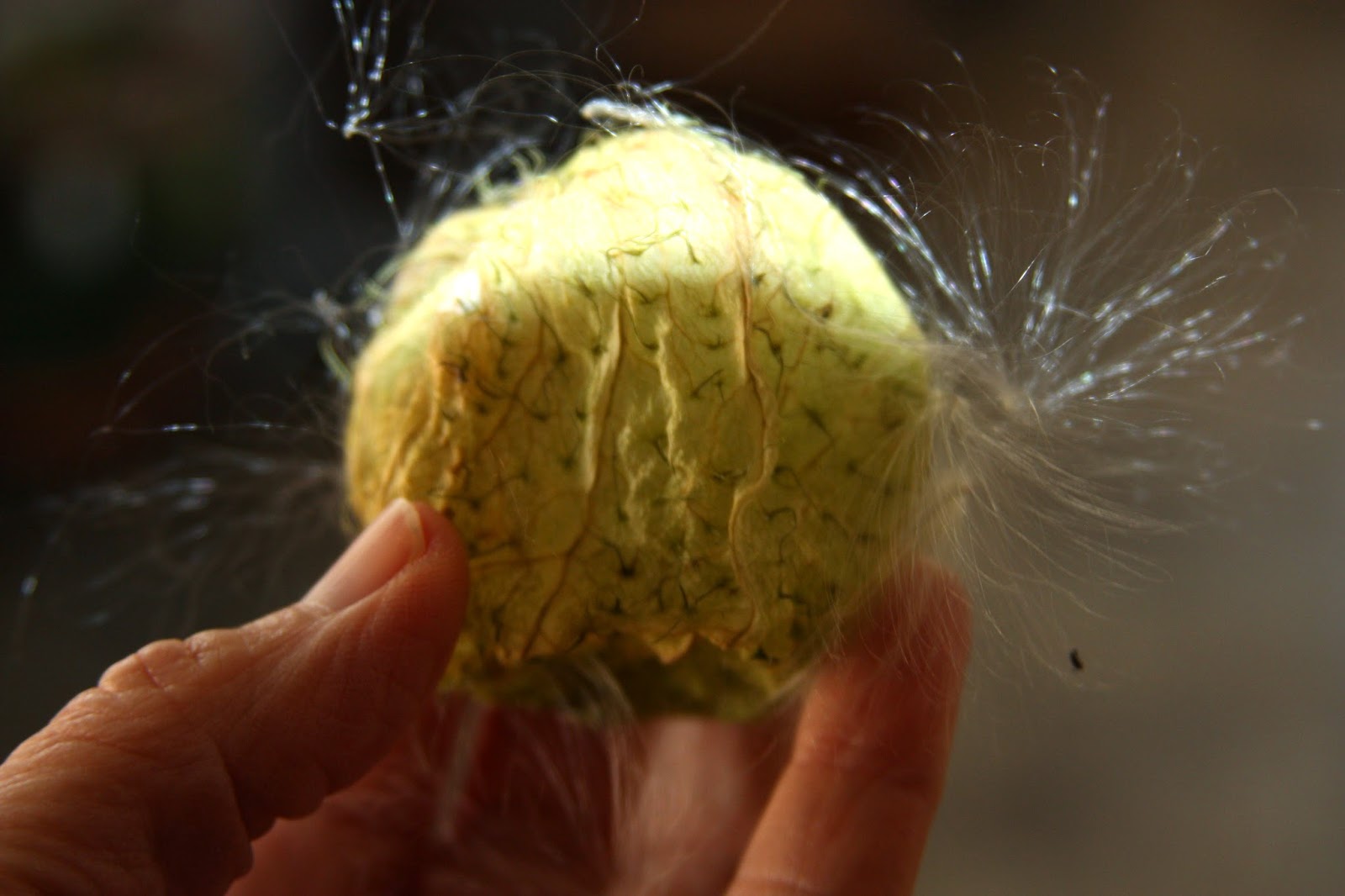Balloon Milkweed was Asclepias physocarpus now Gomphocarpus physocarpus
Monarch butterflies are endangered due to applications of round up and similar products, the clearing of land in Oklahoma and extensive tree removal in Mexico.
We are all being asked to help by planting milkweed. Any variety will do as long as it is planted in swaths large enough to feed caterpillars. The plants don't have to bloom as long as you have water/mud and other nectar providing flowers available for the adults to eat and drink.
In our yard-garden I've seen the adults nectaring on many different flowers but they do seem to love the weedy, native flowering plants more than the tidy ones.
Of all this plant's names, I think I like Family Jewels the best since in addition to the appearance of the pods (ahem), I imagine that the plants will be jewels in our garden, feeding lots and lots of caterpillars this summer.
We usually plant tropical milkweed, Asclepias Tuberosa, as it's the variety I've seen the most caterpillars on. In our garden shed there are flats of seedlings plus a few planted seed trays that will hopefully sprout even more plants.
Today I planted the seeds of a milkweed that is new to me, Balloon Milkweed which is a South African native (zones 8-10). It used to be known as Asclepias physocarpus but now has been reclassified as Gomphocarpus physocarpus.
Whatever its name, Monarch caterpillars eat it and it is a viable choice for our gardens. In fact, according to joyfulbutterfly.com, Gomphocarpus physocarpus is more robust and relisient to the caterpillars chomping than other possible choices.
Our plant friend, Jerry Gustafson sent the four pods that I broke open today to plant. They are to be surface planted with just a bit of vermiculite on top so the seeds get light but are anchored into place by something. We were out of vermiculite so I dribbled Stall Dry on top.
These are tropicals. Germinate best at 69-75 and can take as much as 30-days to pop up. Argh that's a long time for me to wait to see if I'll get any. Oh, well.
If we get a few, I'm promised that they grow 4 to 6 feet tall and 3 feet wide. Perfect for one of the sunny beds in the back of our 2.75 acre lot.
 |
| Family Jewels pod |
 |
| Balloon Milkweed inside the pod |
Of all this plant's names, I think I like Family Jewels the best since in addition to the appearance of the pods (ahem), I imagine that the plants will be jewels in our garden, feeding lots and lots of caterpillars this summer.
 |
| Swan plant seeds |
We usually plant tropical milkweed, Asclepias Tuberosa, as it's the variety I've seen the most caterpillars on. In our garden shed there are flats of seedlings plus a few planted seed trays that will hopefully sprout even more plants.
Today I planted the seeds of a milkweed that is new to me, Balloon Milkweed which is a South African native (zones 8-10). It used to be known as Asclepias physocarpus but now has been reclassified as Gomphocarpus physocarpus.
Whatever its name, Monarch caterpillars eat it and it is a viable choice for our gardens. In fact, according to joyfulbutterfly.com, Gomphocarpus physocarpus is more robust and relisient to the caterpillars chomping than other possible choices.
Our plant friend, Jerry Gustafson sent the four pods that I broke open today to plant. They are to be surface planted with just a bit of vermiculite on top so the seeds get light but are anchored into place by something. We were out of vermiculite so I dribbled Stall Dry on top.
 |
| Gomphocarpus physocarpus pods |
These are tropicals. Germinate best at 69-75 and can take as much as 30-days to pop up. Argh that's a long time for me to wait to see if I'll get any. Oh, well.
If we get a few, I'm promised that they grow 4 to 6 feet tall and 3 feet wide. Perfect for one of the sunny beds in the back of our 2.75 acre lot.



Comments
But you are correct. Milkweed is helpful for so many butterflies that it is good to plant even for those gardeners who are outside the Monarch's migration path.
I do wish milkweed were easier to start from seed. Yikes it is reluctant to get going!
Hope to hear from you about your milkweed plantings and butterfly gardening.